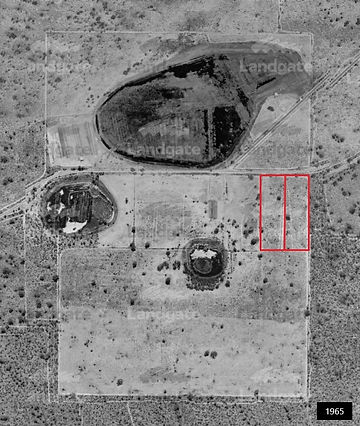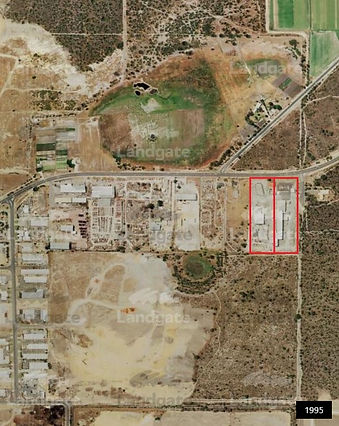
Landsdale Concrete Warehouse
Built over three dates during the 1980’s, this factory and warehouse site was previously occupied by Wembley Cement, Humes Gnangara and Holcim Australia.
It’s very likely they retain ownership of the property, which contains two separate lots of 1.7205 hectares and 2.0310 hectares, particularly as there’s no available property sales history. Obtaining information earlier than 2010 as to who was occupying the premises hasn’t yet been possible but it’s quite likely we can through Readymix into it.
Wembley Cement
ASIC shows this business name was registered on 4 November 2003 and cancelled on 23 August 2018, with a main address of Bentley. An older business name of Wembley Cement Industries was first registered on 24 January 1981 and cancelled on 25 March 1999.
The ABN linked to Wembley Cement Industries (44 003 747 822) is associated with the following entity names:
-
CSR Readymix (Australia) Pty Limited - from 09 May 2002 (current)
-
CSR Readimix (Aust) Pty Ltd - from 05 April 2002 to 09 May 2002
-
CSR Readimix (Aust) Pty Ltd (in liquidation) - from 01 February 2002 to 05 April 2002
-
CSR Readimix (Australia) Pty Limited (in liquidation) - from 08 June 2000 to 01 February 2002.
Business names associated with the ABN:
-
Wempave Paving - from 08 June 2000 to 01 March 2001
-
Territory Asphalt Roadways - from 8 June 2000 to 02 January 2001.
Trading names associated with the ABN:
-
Wembley Cement Industries - from 16 May 2001 (current)
-
CSR Readimix (Australia) Pty Limited (in liquidation) - from 26 April 2001 to 16 May 2001
-
Wembley Cement Industries - from 08 June 2000 to 26 April 2001.
01 - April 2021



















Readymix
Out of all the companies I looked into, Readymix is by far the hardest to find any historic reference for although no doubt, an abundance of information would likely be made available with a more extensive search.
In 1939 Readymix was formed in Glebe, New South Wales and began delivering concrete with their own fleet of truck-mounted tumblers. National expansion followed at the end of World War II with a plant opening in Melbourne, followed by Brisbane a year later in 1946.
Their international expansion began with the United Kingdom in 1952, continually progressing throughout Europe with some 60 plants by the mid 1960's.
Holcim (Australia) Pty Ltd
They are linked to the following business names:
-
Augusta Concrete & Engineering
-
Australian Quarries
-
Beerwah Enterprises
-
Big River Ready-Mixed Concrete
-
Boodles Concrete
-
Cemex Smartslab
-
Coastal Readymix Concrete
-
Donmix
-
Flynn Drive Joint Venture
-
Fox Quarries
-
Grafton Ready Mixed Concrete
-
Humes Brick and Block
-
Humes Concrete Products
-
Hume Pipes
-
Independent Concrete
-
Kerr's Quarries
-
Margaret River Concrete
-
Materials Testing Laboratories
-
Montford Brothers Concrete
-
PF Concrete
-
Readyflow
-
Readymix Concrete
-
Readymix Quarries
-
Readymix Recycled Products
-
Readymix Smartslab
-
Total Readymixed Concrete (Parramatta)
The Start of Holcim
In 1912, Holcim was established by Adolf Gygi in Switzerland. Continuing to be Swiss-based, the company has continued to grow, merge and buy out other companies ever since, becoming one of the biggest producers of building materials and aggregates in the world.
To go into a further history of Holcim would be beyond the scope of this webpage.
02 - September 2021












Humes Australia
Humes is a division of Holcim, supplying and manufacturing building materials in Australia and New Zealand. They were incorporated in August 1920 under the name of Hume Pipe Company (Australia) Limited.
-
1910 – Brothers Ernest James and Walter Reginald establish the Humes’ Patent Cementiron Syndicate Limited in Adelaide, which later becomes the Hume Brothers Cement Iron Company Limited.
-
1920 - The company is renamed Hume Pipe Company (Australia) Limited and incorporated.
-
1923 - Humes Steel Limited is established and they go on to invent the concrete lining of steel pipes
-
1928 - Steel Pipe and Lining Company (Humes) is registered in Victoria
-
1950 - Hume Pipe Company (Australia) Limited changes their name to Humes Limited.
-
1952 - Humes Steel Limited goes into voluntary liquidation and is taken over by Humes Limited as their steel division.
-
1960 - Wunderlich Humes Asbestos Pipes Pty Ltd is formed (jointly owned by Humes and Wunderlich)
-
1964 - James Hardie (Asbestos) Limited takes over Wunderlich.
-
1965 - Wunderlich wounds up
-
1983 – Smorgons begins manufacturing steel products
-
1987 – Smorgons sell their steel operations at a value of $346 million to Humes Ltd, who manufacture steel and manage a distribution operation under the name of The Australian Reinforcing Company (ARC), in return for a 46% stake in Humes Ltd.
-
1988 - Humes Concrete and the 'Hume' name are sold to CSR Limited. Smorgans purchases Humes Ltd for $375 million. They sell off their building products operation and continue to manufacture steel under ARC and Australian Tube Mills.
-
1990 – Humes Limited is changed to CSI Steel Limited (Smorgan Consolidated Industries).
-
1995 – Smorgan Consolidated Industries changes their name to Smorgon Steel.
-
2007 – Smorgan Steel is sold to OneSteel.
Property History
.jpg)
Prior to subdivision commencing in the area, it was nothing more than bushland with a number of swamps
.jpg)
By 1970, a few narrow blocks of land had been converted for use as market gardens
.jpg)
Continuing through to 1977
.jpg)
The area surrounding Landsdale, particularly on the western side, continues being redeveloped for industrial sites. A large sand quarry is located to the north west of the Holcim concrete facility, possibly for the use of the Holcim concrete plant.
.jpg)
The industrial areas continues to grow with bushland being redeveloped for the extension of the industrial estate
.jpg)
Surprisingly there are still a lot of vacant blocks of land in the industrial estate, although housing to the east is completely built
.jpg)
Today the Landsdale and neighbouring areas are quite densely packed, with further bushland areas to the north continuing to be redeveloped by the ever increasing industrial estate.

Today
Street signage for Humes appears to have been taken down sometime between 2017 and 2018.
The Australian Reinforcing Company (ARC), with an entity name of The Australian Steel Company (Operations) Pty Ltd, appears to have occupied the site sometime during 2018 and 2019. It’s quite likely they were based there to supply and/or manufacture building materials for the Mitchell Freeway Extension project on behalf of Holcim Australia.
Seven business names are listed under this entity, including ARC as well as 15 trading names.
The site appears to have been vacant for approximately two years, following the time ARC moved out. 'Abandoned' probably describes it best, as the site appeared to remain unchanged and almost forgotten with time but with a continuation of business and trading names associated with Holcim Australia, it’s quite likely the site was never really abandoned
as as I was led to believe.
Nevertheless, I am definitely thankful for being told about it because now it's another place that's been added to the Perth History Database!
It took about a year for new tenants to occupy part of the site, hence it no longer being classed as vacant.
Photography Experiment
These photos were taken during my second year venturing in urban history. It was at a time when I found it fascinating that you could take a photo of the same thing over and over, yet it would always look different in some way.
I was also interested in seeing how a so-called 'abandoned' place changes over time, although I didn't really photograph this site enough, nor did many people know about this place. Hence why it wasn't heavily graffed up or trashed.
03 - November 2021

























.png)

